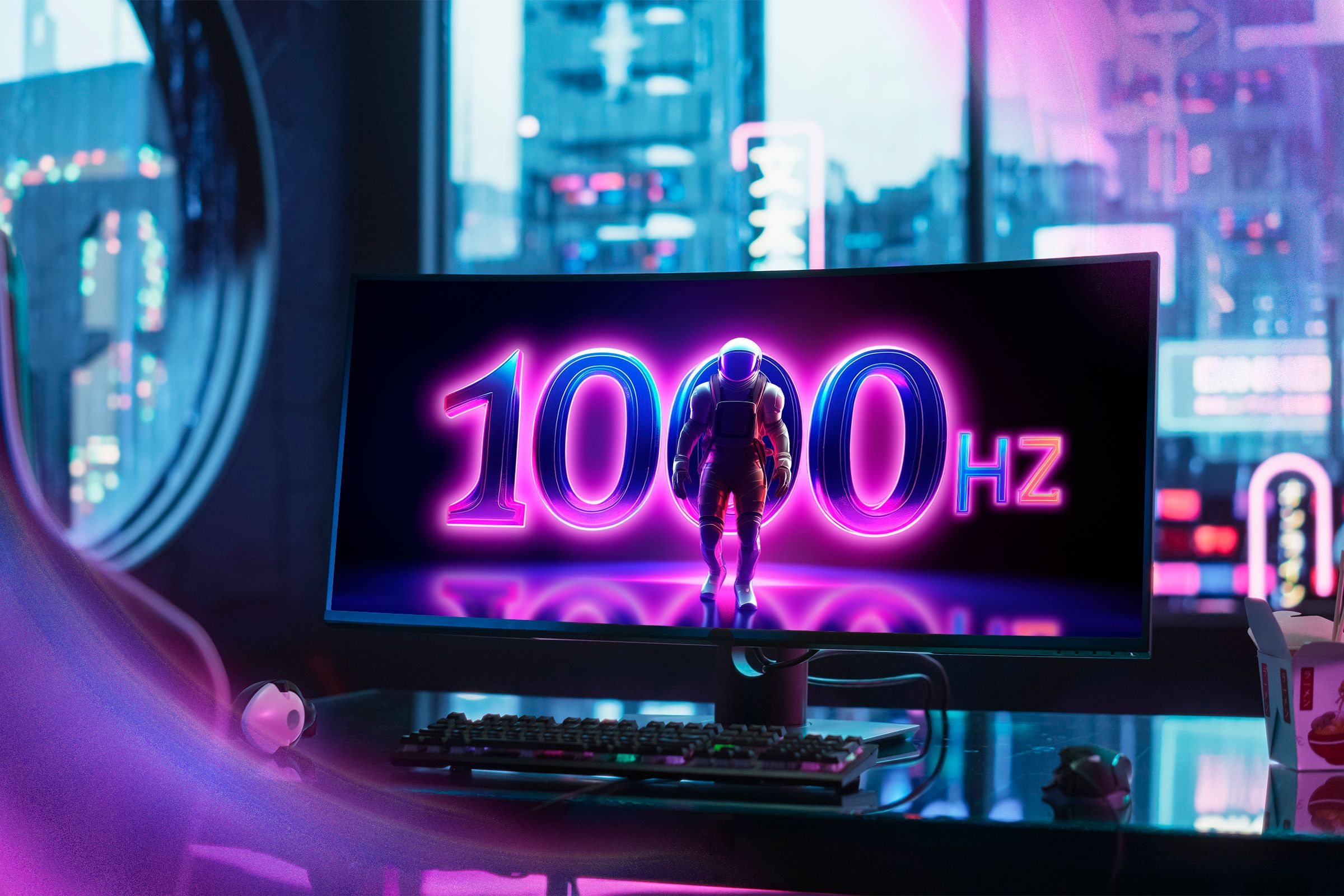
Why the Release of High-Frequency 1000Hz Monitors Is a Game Changer - Top 3 Reasons to Be Thrilled!

Why the Release of High-Frequency 1000Hz Monitors Is a Game Changer - Top 3 Reasons to Be Thrilled!
Key Takeaways
- Enhanced motion clarity with 1000Hz monitor for sharp and crisp visuals without smearing or blurring issues common in flat panel tech.
- Incredibly low latency provides responsive and snappy visuals in gaming, eliminating frame tearing and reducing input delay significantly.
- Enjoy reduced flicker with 1000Hz screen, making it imperceptible to the naked eye and improving overall viewing experience for all users.
TCL has shown off a 4K 1000Hz monitor, the latest in the race to have the highest refresh rate on a flat panel. This has caused many eyes to roll and comments like “there’s no 1000Hz content” to come spilling from the web, but you don’t need special content to enjoy the benefits of such a high refresh rate. I’m excited for somewhat different reasons.
Superior Motion Clarity at Any Frame Rate
The first thing I thought of when I first saw the announcement of TCL’s monitor wasn’t frame rates, but motion clarity.
Flat panel technology has struggled with smearing and blurring since day one. This was one of the biggest downgrades when we moved from CRTs to LCD technology, and even the latest top-end OLED panels still don’t compare favorably with the best CRTs. There are several reasons why this smearing appears, but one of the main culprits happens because of the “sample and hold” nature of these displays.
Basically, flat panel screens can instantly switch from one image to another, or perfectly hold the same image with no deviation indefinitely. Because of the way our vision works, this leads to a perception of smearing and blur. CRTs did not suffer from this, because there’s a natural period of decay in between each refresh. This means that the image is pulsed with a brief blank screen. You can’t see this with the naked eye, but it results in sharp motion.
Some modern flat panel displays can simulate this by using a technique known as BFI or Black Frame Insertion . This works by inserting a black frame in between every regular frame, which results in a dramatic increase in motion clarity. However, it also causes a dip in brightness and vibrancy, since you are now only receiving about half the light you were before.
With 1000Hz of refreshing at your disposal, you can insert black frames in a range of proportions, barely dent the overall brightness of the image, and still offer crisp clarity. That’s on top of the inherent motion clarity from having such snappy pixels.
Incredibly Low Latency

There are various types of latency that affect what you see on your screen, and more importantly, when you see it. For example, there’s a time delay between something changing internally in a computer program and the result being shown on your screen. For example, an enemy player or character moving into view and shooting at you, happens a fraction of a second before you actually see it on screen. This is because it takes time for the data leaving your graphics card to become an image on your display.
Then we have input latency, which is the total time it takes from you pressing a button, and seeing the result of that input on your screen. This affects every type of software, but it is most keenly felt in video games, as you might expect. Regardless, the very soonest that a monitor can show you the latest image data on-screen is when the next screen refresh comes around. The faster the monitor shows you the latest image data, the snappier and more responsive things will feel.
This can go wrong as well, as in the case of “frame tearing “ where the image data is updated partway through a refresh, and you’ll see part of one frame and the next fused into one. This presents as a “tear” across the screen. Vsync fixes this by delaying each frame until the next refresh is ready at the cost of latency. screens, capable of variable refresh rates , dynamically change when the next refresh happens, so it offers better responsiveness than Vsync. Besides that, variable refresh rate technology comes with its own set of issues .
Now, with a thousand refreshes per second, I feel that variable refresh rates might virtually become obsolete, since even with Vsync on the longest you’ll have to wait for the next refresh is 1/1000th of a second. That single millisecond of delay from waiting for the next refresh is such a small slice of time it’s imperceptible.
Less Flicker
The last major reason I’m looking forward to laying eyes on a 1000Hz screen is the reduction in flicker it will bring. Sadly, most of the attempts at getting better motion clarity on LCD screens have resulted in the introduction of flicker. Some people are more sensitive to it than others, but I’ve personally seen BFI that flickers so much it’s unusable. Flicker from VRR can happen for a variety of reasons, none of them less annoying than the next, and of course, even without these features, some LCDs just flicker inherently.
At 1000Hz, you’d need a fancy high-speed camera to detect any flicker at all, and not even a fighter pilot could claim to see it with the naked eye at such a high refresh rate. So, even if you don’t have any games that can run at 1000fps, or you just work in office apps all day, ultra-high refresh rates are something to celebrate and look forward to.
Also read:
- [New] 2024 Approved The Ultimate Playlist Plan for Insta
- [New] Unlocking Instagram's Potential Elevating Content Impact for 2024
- [Updated] 2024 Approved Simple Steps Adding Comprehensive Captions to YouTube Videos
- [Updated] Eliminating an Obsolete LinkedIn Identity Stepwise Guide
- [Updated] In 2024, Affordable GoPros Where to Buy with Best Price
- Download and Install Official Nvidia 940MX Graphics Card Drivers
- Fixing AMD Vega 64 Graphics Card Issues with the Newest Windows Drivers – Your Solution Here!
- Get Your Epson ES-400 Compatible Software Installed in Windows Now
- Get Your Samsung C460 Driver Downloaded Fast and Easy - Guide Here
- How To Repair A Malfunctioning Samsung Blu Ray Media Device
- How to Repair Your Logitech G13 Controller Using Official Drivers
- HP Photosmart Prise 7520 Drivers for Quick and Easy Installation
- In 2024, The Most Useful Tips for Pokemon Go Ultra League On Meizu 21 | Dr.fone
- Investigating Allegations Againnst Intel: Class Action Over Processor Performance Failures Begins
- Leveraging Likes A Guide to Profitable Vimeo Marketing for 2024
- New Wave of Mobile CPU Problems Emerge in 14Th and 15Th Gen: Intel Attributes to Different Root Cause than Inherent Flaw in Desktops
- Puzzled by Dxgi.dll, Now Resolved
- Resolve Twitter Vids Playback Issue for 2024
- Top 3 Highest-Rated Free DVD Transcoding Software
- Title: Why the Release of High-Frequency 1000Hz Monitors Is a Game Changer - Top 3 Reasons to Be Thrilled!
- Author: Richard
- Created at : 2024-12-10 19:20:46
- Updated at : 2024-12-12 19:26:57
- Link: https://hardware-updates.techidaily.com/why-the-release-of-high-frequency-1000hz-monitors-is-a-game-changer-top-3-reasons-to-be-thrilled/
- License: This work is licensed under CC BY-NC-SA 4.0.